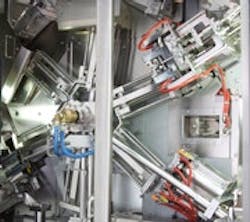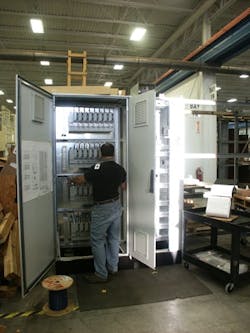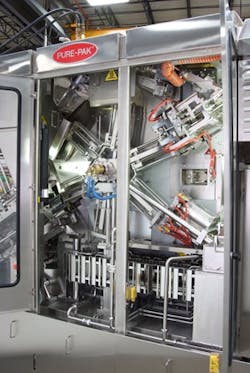Electrical Design Allows Engineers to Share Information and Speed Results
By Phil Burgert
Improved schematic-design efficiency, improved quality, error checking and sharing of documents and data are among the advantages that controls engineers cite for working with current-generation electrical computer-aided design (E-CAD) systems.
E-CAD can provide the tools to contain a complete design in a single project.
In addition the software can let users navigate quickly through the schematics and take advantage of automatic referencing, error checking, searching and other tools across the entire set of pages.
Database Has It All
"An E-CAD project database also can contain background information such as part numbers, engraving text, PLC and functional data that can be searched and extracted in reports or data sets for various end users." says Bruce Davey, electrical drafter with Curt G. Joa (www.joa.com), manufacturer of machinery for production of disposal products such as diapers and sanitary napkins. Based in Sheboygan Falls, Wis., the company designs and builds machines (Figure 1) that require upwards of a thousand pages of electrical schematics, says Davey.
Joa also uses the basic copy-and-paste advantage of CAD for leverage by having all the pages merged and organized under a single project, adds Davey.
Packaging machinery manufacturer Elopak (www.elopak.com), New Hudson, Mich., uses E-CAD to standardize designs and maximize efficiency (Figure 2), says Michael Ballinger, electrical engineer. "With an E-CAD system we can regulate and maintain specific circuit designs as we apply them across different machine functions," he explains. "This enables us to build a macro library of circuits to improve efficiency and shorten design time.
E-CAD software extends the capabilities of a single designer by improving his design and validation efforts, says Ballinger, adding that these systems also can handle part standardization and management, which is important within repeatable hardware designs and project budgets. "An E-CAD system not only gives a single designer an advantage, it enables the company as a whole to achieve consistency and uniformity throughout the designing process," he says.
Dave Sprague, electrical engineer with Stolle Machinery (www.stollemachinery.com), Sidney, Ohio, says E-CAD has helped improve the company's output in the six years the company has been a user. "We've reassigned a third of our electrical engineering workforce, and we've basically doubled our workload with just using two-thirds of what we had before," says Sprague. "It tremendously increases your productivity.”
Speed, Accuracy and Appearance
E-CAD also can step up the accuracy of the drawings through use of automatic cross-referencing and automated parts. "Let's say you're adding another contact for a motor starter that you have defined already," offers Sprague. "In the past and you might have forgotten you used all your contacts already. With this software it clues you in that you've used them all and that you might want to add an outer deck for that. It keeps you out of trouble that way.”
E-CAD has worked well for Stolle. "This is more of a personal opinion, but I've heard it said many times that the looks of the drawings have improved. They are a lot more polished and professional," says Sprague. He notes that Stolle moved directly to its current E-CAD system from manual drawings. "These packages now automate so many functions that it speeds you up and it makes it a whole lot easier to do, and product looks a lot better," he explains.
Rodney Price, manager of electrical engineering for Belvac Production Machinery (www.belvac.com), Lynchburg, Va., has used E-CAD for several years to create schematics and to make input/output (I/O) assignments for translation to PLC programs. "E-CAD provides speed, accuracy and standardization," he says. "The goal is to have it also generate our bill of material. We haven't quite gotten there, but we're driving toward that point. We'll do a schematic and, from the schematic, the bill of material is then generated.”
The key difference between manual design and using the intelligence in E-CAD programs is accuracy, says Price. "You get the intelligence with it so you have error-proofing that allows you to be more accurate with referencing," he says. "That's what we were looking for. We wanted to get accurate drawings out to the customer in a timely manner, and this is helping us do that.”
A Global Advantage
"Through our current E-CAD product, Eplan, sharing design data across our global organization has become effortless due to the use of multilingual database translations and PDF exports," says Elopak's Ballinger. Eplan has a database language translation that enables Elopak to translate documentation into as many languages as necessary, he adds, while noting that PDF exports from the program have improved documentation-sharing by shortening the time needed to create a PDF document. "This function also maintains the navigational links that are used inside Eplan, allowing the user full navigation control throughout the documentation," he says.
Davey at Curt G. Joa says PDF export of projects along with PLC, cable and other technical function extracts are beneficial to electronic transfer of engineering information both internally and externally. "We can work parallel design paths by electronically sharing information at an earlier stage in the process," he says. "This leads to compressed delivery schedules.”
Mark Taylor, executive vice president and general manager of Eplan Software & Services (www.eplan.us) says a large portion of the company's North American customer base has global market requirements. "They can convert languages, they can translate language, and the part data goes with it," says Taylor. "All the engineering data goes with it. Everything is in one data file. It can't be a collection of auxiliary databases and individual sheets.”
Arthur Sawall, vice president of global electrical business development for ECT Bentley (www.bentley.com) shares the example of Procter & Gamble, one of its E-CAD customers that shares designs globally. "They could be designing something in Germany and that design might go into a plant here in the U.S. or in Korea or China," says Sawall. "So they use an E-CAD tool, which uses an underlying database to store all of the information either in SQL Server or Oracle. All the graphical entities are stored in a database. By doing that I can share that design basically in any language and E-CAD helps facilitate the translation of languages.”
Reuse, Don't Reinvent
Data-driven E-CAD also allows engineers to enter the data once and then represent it many times in different formats throughout a schematic set, as well as external reports and data sets, says Joa's Davey. "This not only saves time, but avoids costly errors," he says, adding that his company prevents E-CAD software library maintenance problems by mainly using symbol sets provided by its Eplan. "If they have done a good job creating the building blocks, the rest falls into place very nicely," he says.
Elopak's Ballinger says his company's E-CAD manages data within projects through a database that gives the user complete access to how information is displayed, manipulated and created. "Data-driven tools allow the user to generate automated reports that identify important features such as table of contents, wire connection lists and revision-control overview reports," he says.
Elopak uses the data-driven tools to develop designs in two stages. "First, the user identifies different functions of the machine and designs the circuitry to fit the specified functions," he says. "Second, using the user combines these functional circuit designs into one cohesive project. By using the data-driven tools within Eplan, the designer can view the project in any number of combinations to fit the need of the designer.”
Elopak chose to maintain libraries of symbols and device data within its E-CAD system by giving one employee from each of its electrical, pneumatics and process controls disciplines responsibility to oversee parts management data and a macro library through Eplan's Electric P8, Fluid and PPE software programs. They also are responsible for teaching co-workers how to enter device data and create symbols.
Sprague at Stolle Machinery says his company uses its Bentley E-CAD system to import data and parts from the other manufacturers. "You can import all that data straight in there, which means you don't have to create the part by hand," he says. "That increases productivity and the time spent on the drawings.”
Data-driven E-CAD tools can improve efficiency by cutting down on designing steps, says Belvac's Price. "If you're doing a CAD drawing in Autocad, every five minutes you have to hit the save button so you won't lose any work if something crashes," he says. "Since Eplan is completely database-driven, as soon as you create a line it's recorded in the database.”
Belvac, he says, maintains its libraries of symbols and parts on a network server so they are unified. "We set each work station up to refer to the same image file folder on the network drive," he says. "That way we all work from the same bucket of tools.”
Future Enhancement
The next need for E-CAD, say several of the users, is to improve how it works with open architectures. "The ability of E-CAD to work on open-standard architecture would improve compatibility across the industry significantly," says Elopak's Ballinger. "One compatability advancement that could be done now would be to standardize parts management libraries and symbol libraries of E-CAD systems.”
Ballinger notes that such companies as Siemens, Jokab Safety or Rockwell Automation should be willing and able to enter their parts data in a standardized form that would make the information available to all E-CAD systems. "This would considerably minimize the data entry process at the early stage of an E-CAD integration and would simplify the maintenance on these libraries later," he says.
Stolle's Sprague notes that open-standard architectures make it easier for users to figure out what is happening inside the software when something goes wrong. "That's improved significantly with the different E-CAD software revisions we've been through in the past six years," he says. "It is pretty easy to find anything, see what it's doing and where and change that if necessary. It's not as cryptic as it was years ago when it first started out.”
Eplan's Taylor says there are multiple levels of data transparency and his company has been working for transparency in its products. But, he notes that he has discussions with customers at venues such as Control Design's annual AutomationXchange event on the importance of transferring engineering data across the enterprise. "It is important that I can share something with the fluid engineer or the process engineer," he says. "But it is equally and maybe even more important that I can share it with purchasing or with my panel-build shop or with my manufacturing environment. This is critical. So we provide all kinds of ties into the data whether it is XML or it's OPC. There are all kinds of ties that make that data completely accessible. There has to be complete data accessibility even to the point of carrying that to the PLCs."
Philip Burgert is a freelance writer specialing in technical trade media.



